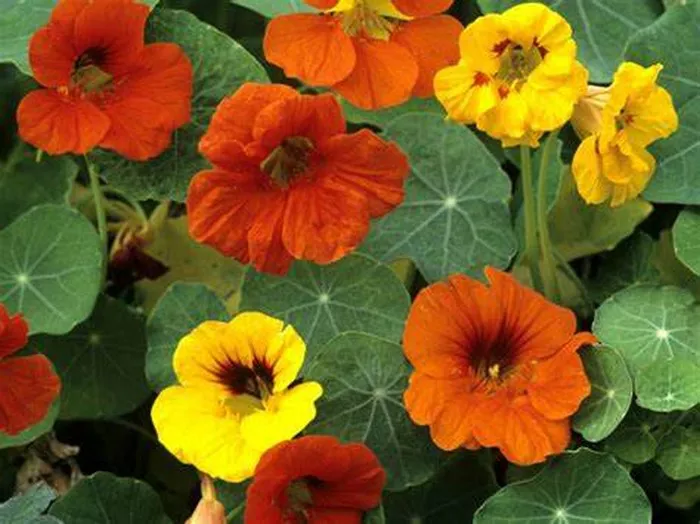Nestled in gardens and gracing plates with their vibrant presence, nasturtium flowers are a delightful addition to both culinary and ornamental landscapes. With their bold hues and peppery flavor, these blossoms captivate not only the eyes but also the taste buds. Let’s embark on a journey to unravel the charm and versatility of nasturtium flowers.
A Botanical Marvel: Understanding Nasturtium Flowers
Nasturtiums, scientifically known as Tropaeolum majus, belong to the genus Tropaeolum and hail from South and Central America. These annual plants, characterized by their trailing or climbing stems and rounded leaves, produce an abundance of brightly colored flowers. Available in shades ranging from fiery oranges and yellows to rich reds, nasturtium blooms add a burst of color to any garden.
One distinctive feature of nasturtium flowers is their spur at the back, reminiscent of a bird’s talon, which gives them a unique appearance. The name “nasturtium” itself originates from the Latin word “nasus tortus,” meaning twisted nose, a nod to the reaction their peppery taste can evoke.
Culinary Delights: Nasturtiums in the Kitchen
Beyond their ornamental value, nasturtium flowers offer a culinary adventure. Both the flowers and leaves of nasturtium plants are edible, boasting a peppery flavor akin to arugula or watercress. This culinary versatility makes nasturtiums a favorite among chefs and home cooks alike.
Nasturtium flowers can be used in a variety of ways in the kitchen. They make visually stunning additions to salads, lending a spicy kick and a pop of color to the dish. The vibrant blooms can also be stuffed with savory fillings or used as a garnish for soups and appetizers. Additionally, nasturtium leaves can be incorporated into pestos or blended into sauces to impart their distinct peppery taste.
One popular use of nasturtium flowers is to pickle them, preserving their vibrant colors and peppery flavor for enjoyment throughout the year. Pickled nasturtium buds can be used as a unique substitute for capers, adding a tangy punch to salads, pasta dishes, and sauces.
Medicinal Properties: Nasturtiums as Herbal Remedies
In addition to their culinary appeal, nasturtium flowers have a long history of medicinal use. Traditional herbalists have recognized the therapeutic properties of nasturtiums, harnessing their healing potential for various ailments.
One notable benefit of nasturtium flowers is their natural antibiotic properties. They contain compounds such as glucotropaeolin, which exhibit antibacterial activity against a range of pathogens. This makes nasturtiums a valuable ally in supporting the immune system and fighting infections.
Furthermore, nasturtiums are rich in vitamin C, an essential nutrient known for its immune-boosting properties. Consuming nasturtium flowers can help fortify the body’s defenses against illnesses and promote overall health and well-being.
Nasturtiums also possess expectorant properties, making them effective in relieving respiratory conditions such as coughs and bronchitis. Their ability to help clear congestion and soothe irritated airways has earned them a place in traditional herbal remedies for respiratory ailments.
Gardening Gems: Cultivating Nasturtiums
For gardening enthusiasts, growing nasturtiums can be a rewarding experience. These hardy plants are relatively easy to cultivate, making them suitable for gardeners of all skill levels. Whether planted in garden beds, containers, or hanging baskets, nasturtiums thrive in various growing conditions.
Nasturtiums prefer well-drained soil and plenty of sunlight, although they can tolerate partial shade. They are also relatively drought-tolerant once established, making them a low-maintenance addition to the garden. Regular deadheading encourages continuous blooming throughout the growing season, ensuring a steady supply of colorful flowers.
One of the joys of growing nasturtiums is witnessing their rapid growth and abundant blooms. From sowing seeds to enjoying a cascade of flowers, the lifecycle of nasturtium plants is a testament to nature’s beauty and resilience.
Companion Planting: Nasturtiums in the Garden
Beyond their aesthetic appeal, nasturtiums offer practical benefits in the garden as well. Their natural pest-repelling properties make them valuable companions to a variety of vegetables and herbs. By interplanting nasturtiums with other crops, gardeners can help deter pests and promote a healthier garden ecosystem.
Nasturtiums are particularly effective at repelling aphids, whiteflies, and cucumber beetles, which can wreak havoc on vegetable gardens. The pungent scent of nasturtiums acts as a deterrent, reducing the likelihood of pest infestations and minimizing the need for chemical interventions.
Additionally, nasturtiums can attract beneficial insects such as ladybugs and hoverflies, which prey on garden pests. By creating a welcoming habitat for these beneficial insects, nasturtiums contribute to a more balanced and sustainable garden environment.
Symbolism and Cultural Significance
Throughout history, nasturtium flowers have held symbolic significance in various cultures around the world. In Victorian times, the language of flowers, or floriography, was a popular means of communication, with each flower carrying its own symbolic meaning.
Nasturtiums were often associated with conquest and victory, owing to their vibrant colors and resilient nature. In some cultures, nasturtium flowers symbolize patriotism and national pride, while in others, they represent courage and bravery in the face of adversity.
In the language of flowers, the color of nasturtium blooms also carries specific meanings. For example, red nasturtiums are often associated with passion and love, while yellow nasturtiums symbolize warmth and friendship.
Conclusion
Nasturtium flowers embody a blend of beauty, flavor, and versatility that makes them a cherished addition to gardens and kitchens worldwide. From their eye-catching blooms to their peppery taste and medicinal properties, nasturtiums captivate the senses and inspire creativity.
Whether adorning salads, brightening garden beds, or serving as natural pest deterrents, nasturtium flowers enrich our lives in myriad ways. As we celebrate their charm and resilience, let us savor the vibrancy of nasturtiums and embrace the beauty they bring to our homes and communities.


